《英语学科知识与教学能力》(高级中学)
- 格式:docx
- 大小:20.59 KB
- 文档页数:8
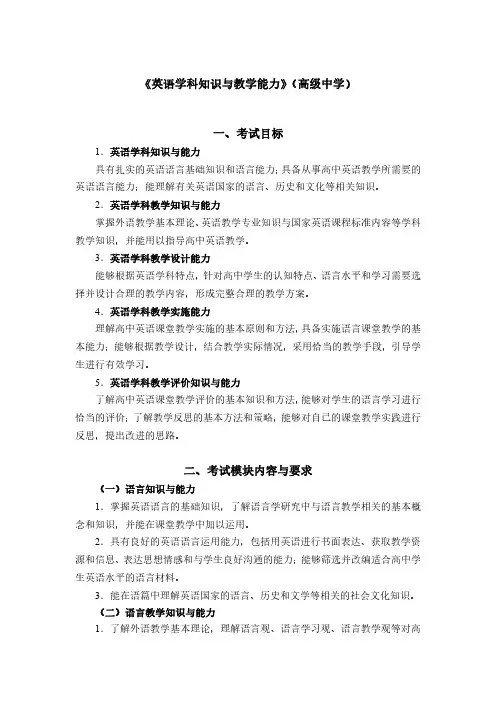
《英语学科知识与教学能力》(高级中学)一、考试目标1.英语学科知识与能力具有扎实的英语语言基础知识和语言能力;具备从事高中英语教学所需要的英语语言能力;能理解有关英语国家的语言、历史和文化等相关知识。
2.英语学科教学知识与能力掌握外语教学基本理论、英语教学专业知识与国家英语课程标准内容等学科教学知识,并能用以指导高中英语教学。
3.英语学科教学设计能力能够根据英语学科特点,针对高中学生的认知特点、语言水平和学习需要选择并设计合理的教学内容,形成完整合理的教学方案。
4.英语学科教学实施能力理解高中英语课堂教学实施的基本原则和方法,具备实施语言课堂教学的基本能力;能够根据教学设计,结合教学实际情况,采用恰当的教学手段,引导学生进行有效学习。
5.英语学科教学评价知识与能力了解高中英语课堂教学评价的基本知识和方法,能够对学生的语言学习进行恰当的评价;了解教学反思的基本方法和策略,能够对自己的课堂教学实践进行反思,提出改进的思路。
二、考试模块内容与要求(一)语言知识与能力1.掌握英语语言的基础知识,了解语言学研究中与语言教学相关的基本概念和知识,并能在课堂教学中加以运用。
2.具有良好的英语语言运用能力,包括用英语进行书面表达、获取教学资源和信息、表达思想情感和与学生良好沟通的能力;能够筛选并改编适合高中学生英语水平的语言材料。
3.能在语篇中理解英语国家的语言、历史和文学等相关的社会文化知识。
(二)语言教学知识与能力1.了解外语教学基本理论,理解语言观、语言学习观、语言教学观等对高中英语教学的指导作用。
2.理解国家颁布的英语学科课程标准的目标内容(语言技能、语言知识、情感态度、学习策略和文化意识),以及课程标准的其他相关知识,并能在教学设计与实施中运用。
3.掌握英语语言知识(语音、词汇、语法、语篇等)的教学基本原则、讲解和练习方法。
4.掌握英语语言技能(听、说、读、写)教学的基本原则和训练方法。
5.能结合中外社会文化语境,设计并实施英语知识和技能的教学与训练。
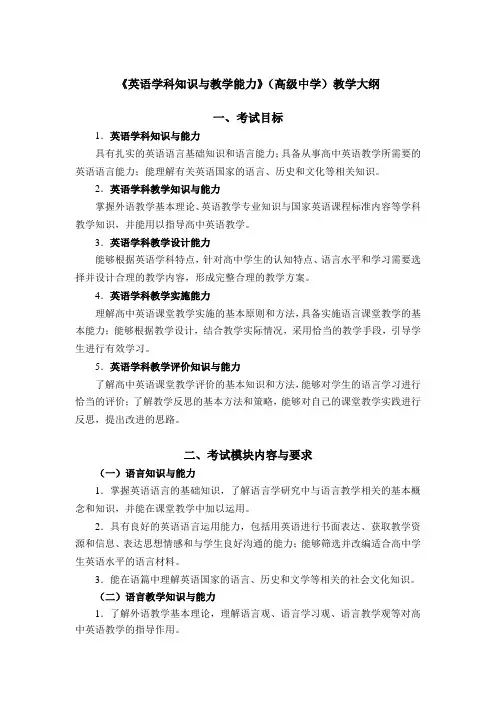
《英语学科知识与教学能力》(高级中学)教学大纲一、考试目标1.英语学科知识与能力具有扎实的英语语言基础知识和语言能力;具备从事高中英语教学所需要的英语语言能力;能理解有关英语国家的语言、历史和文化等相关知识。
2.英语学科教学知识与能力掌握外语教学基本理论、英语教学专业知识与国家英语课程标准内容等学科教学知识,并能用以指导高中英语教学。
3.英语学科教学设计能力能够根据英语学科特点,针对高中学生的认知特点、语言水平和学习需要选择并设计合理的教学内容,形成完整合理的教学方案。
4.英语学科教学实施能力理解高中英语课堂教学实施的基本原则和方法,具备实施语言课堂教学的基本能力;能够根据教学设计,结合教学实际情况,采用恰当的教学手段,引导学生进行有效学习。
5.英语学科教学评价知识与能力了解高中英语课堂教学评价的基本知识和方法,能够对学生的语言学习进行恰当的评价;了解教学反思的基本方法和策略,能够对自己的课堂教学实践进行反思,提出改进的思路。
二、考试模块内容与要求(一)语言知识与能力1.掌握英语语言的基础知识,了解语言学研究中与语言教学相关的基本概念和知识,并能在课堂教学中加以运用。
2.具有良好的英语语言运用能力,包括用英语进行书面表达、获取教学资源和信息、表达思想情感和与学生良好沟通的能力;能够筛选并改编适合高中学生英语水平的语言材料。
3.能在语篇中理解英语国家的语言、历史和文学等相关的社会文化知识。
(二)语言教学知识与能力1.了解外语教学基本理论,理解语言观、语言学习观、语言教学观等对高中英语教学的指导作用。
2.理解国家颁布的英语学科课程标准的目标内容(语言技能、语言知识、情感态度、学习策略和文化意识),以及课程标准的其他相关知识,并能在教学设计与实施中运用。
3.掌握英语语言知识(语音、词汇、语法、语篇等)的教学基本原则、讲解和练习方法。
4.掌握英语语言技能(听、说、读、写)教学的基本原则和训练方法。
5.能结合中外社会文化语境,设计并实施英语知识和技能的教学与训练。
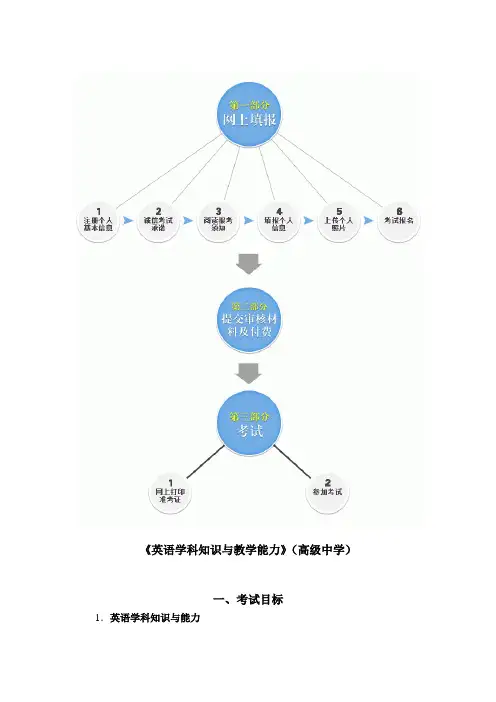
《英语学科知识与教学能力》(高级中学)一、考试目标1.英语学科知识与能力具有扎实的英语语言基础知识和语言能力;具备从事高中英语教学所需要的英语语言能力;能理解有关英语国家的语言、历史和文化等相关知识。
2.英语学科教学知识与能力掌握外语教学基本理论、英语教学专业知识与国家英语课程标准内容等学科教学知识,并能用以指导高中英语教学。
3.英语学科教学设计能力能够根据英语学科特点,针对高中学生的认知特点、语言水平和学习需要选择并设计合理的教学内容,形成完整合理的教学方案。
4.英语学科教学实施能力理解高中英语课堂教学实施的基本原则和方法,具备实施语言课堂教学的基本能力;能够根据教学设计,结合教学实际情况,采用恰当的教学手段,引导学生进行有效学习。
5.英语学科教学评价知识与能力了解高中英语课堂教学评价的基本知识和方法,能够对学生的语言学习进行恰当的评价;了解教学反思的基本方法和策略,能够对自己的课堂教学实践进行反思,提出改进的思路。
二、考试模块内容与要求(一)语言知识与能力1.掌握英语语言的基础知识,了解语言学研究中与语言教学相关的基本概念和知识,并能在课堂教学中加以运用。
2.具有良好的英语语言运用能力,包括用英语进行书面表达、获取教学资源和信息、表达思想情感和与学生良好沟通的能力;能够筛选并改编适合高中学生英语水平的语言材料。
3.能在语篇中理解英语国家的语言、历史和文学等相关的社会文化知识。
(二)语言教学知识与能力1.了解外语教学基本理论,理解语言观、语言学习观、语言教学观等对高中英语教学的指导作用。
2.理解国家颁布的英语学科课程标准的目标内容(语言技能、语言知识、情感态度、学习策略和文化意识),以及课程标准的其他相关知识,并能在教学设计与实施中运用。
3.掌握英语语言知识(语音、词汇、语法、语篇等)的教学基本原则、讲解和练习方法。
4.掌握英语语言技能(听、说、读、写)教学的基本原则和训练方法。
5.能结合中外社会文化语境,设计并实施英语知识和技能的教学与训练。
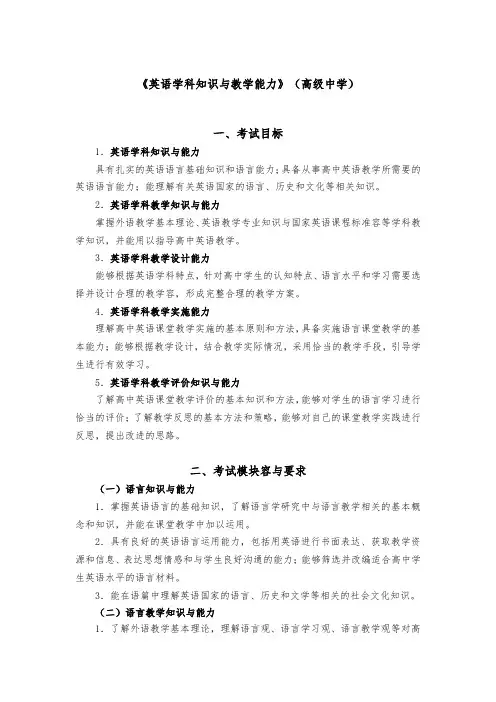
《英语学科知识与教学能力》(高级中学)一、考试目标1.英语学科知识与能力具有扎实的英语语言基础知识和语言能力;具备从事高中英语教学所需要的英语语言能力;能理解有关英语国家的语言、历史和文化等相关知识。
2.英语学科教学知识与能力掌握外语教学基本理论、英语教学专业知识与国家英语课程标准容等学科教学知识,并能用以指导高中英语教学。
3.英语学科教学设计能力能够根据英语学科特点,针对高中学生的认知特点、语言水平和学习需要选择并设计合理的教学容,形成完整合理的教学方案。
4.英语学科教学实施能力理解高中英语课堂教学实施的基本原则和方法,具备实施语言课堂教学的基本能力;能够根据教学设计,结合教学实际情况,采用恰当的教学手段,引导学生进行有效学习。
5.英语学科教学评价知识与能力了解高中英语课堂教学评价的基本知识和方法,能够对学生的语言学习进行恰当的评价;了解教学反思的基本方法和策略,能够对自己的课堂教学实践进行反思,提出改进的思路。
二、考试模块容与要求(一)语言知识与能力1.掌握英语语言的基础知识,了解语言学研究中与语言教学相关的基本概念和知识,并能在课堂教学中加以运用。
2.具有良好的英语语言运用能力,包括用英语进行书面表达、获取教学资源和信息、表达思想情感和与学生良好沟通的能力;能够筛选并改编适合高中学生英语水平的语言材料。
3.能在语篇中理解英语国家的语言、历史和文学等相关的社会文化知识。
(二)语言教学知识与能力1.了解外语教学基本理论,理解语言观、语言学习观、语言教学观等对高中英语教学的指导作用。
2.理解国家颁布的英语学科课程标准的目标容(语言技能、语言知识、情感态度、学习策略和文化意识),以及课程标准的其他相关知识,并能在教学设计与实施中运用。
3.掌握英语语言知识(语音、词汇、语法、语篇等)的教学基本原则、讲解和练习方法。
4.掌握英语语言技能(听、说、读、写)教学的基本原则和训练方法。
5.能结合中外社会文化语境,设计并实施英语知识和技能的教学与训练。
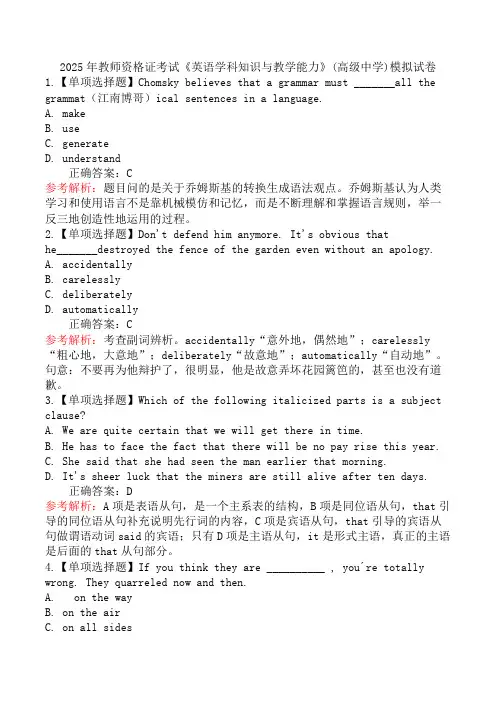
2025年教师资格证考试《英语学科知识与教学能力》(高级中学)模拟试卷1.【单项选择题】Chomsky believes that a grammar must _______all the grammat(江南博哥)ical sentences in a language.A. makeB. useC. generateD. understand正确答案:C参考解析:题目问的是关于乔姆斯基的转换生成语法观点。
乔姆斯基认为人类学习和使用语言不是靠机械模仿和记忆,而是不断理解和掌握语言规则,举一反三地创造性地运用的过程。
2.【单项选择题】Don't defend him anymore. It's obvious thathe_______destroyed the fence of the garden even without an apology.A. accidentallyB. carelesslyC. deliberatelyD. automatically正确答案:C参考解析:考查副词辨析。
accidentally“意外地,偶然地”;carelessly “粗心地,大意地”;deliberately“故意地”;automatically“自动地”。
句意:不要再为他辩护了,很明显,他是故意弄坏花园篱笆的,甚至也没有道歉。
3.【单项选择题】Which of the following italicized parts is a subject clause?A. We are quite certain that we will get there in time.B. He has to face the fact that there will be no pay rise this year.C. She said that she had seen the man earlier that morning.D. It's sheer luck that the miners are still alive after ten days.正确答案:D参考解析:A项是表语从句,是一个主系表的结构,B项是同位语从句,that引导的同位语从句补充说明先行词的内容,C项是宾语从句,that引导的宾语从句做谓语动词said的宾语;只有D项是主语从句,it是形式主语,真正的主语是后面的that从句部分。
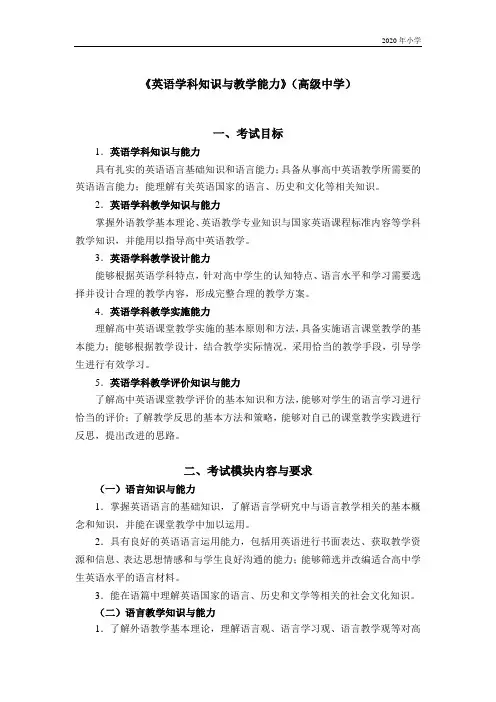
《英语学科知识与教学能力》(高级中学)一、考试目标1.英语学科知识与能力具有扎实的英语语言基础知识和语言能力;具备从事高中英语教学所需要的英语语言能力;能理解有关英语国家的语言、历史和文化等相关知识。
2.英语学科教学知识与能力掌握外语教学基本理论、英语教学专业知识与国家英语课程标准内容等学科教学知识,并能用以指导高中英语教学。
3.英语学科教学设计能力能够根据英语学科特点,针对高中学生的认知特点、语言水平和学习需要选择并设计合理的教学内容,形成完整合理的教学方案。
4.英语学科教学实施能力理解高中英语课堂教学实施的基本原则和方法,具备实施语言课堂教学的基本能力;能够根据教学设计,结合教学实际情况,采用恰当的教学手段,引导学生进行有效学习。
5.英语学科教学评价知识与能力了解高中英语课堂教学评价的基本知识和方法,能够对学生的语言学习进行恰当的评价;了解教学反思的基本方法和策略,能够对自己的课堂教学实践进行反思,提出改进的思路。
二、考试模块内容与要求(一)语言知识与能力1.掌握英语语言的基础知识,了解语言学研究中与语言教学相关的基本概念和知识,并能在课堂教学中加以运用。
2.具有良好的英语语言运用能力,包括用英语进行书面表达、获取教学资源和信息、表达思想情感和与学生良好沟通的能力;能够筛选并改编适合高中学生英语水平的语言材料。
3.能在语篇中理解英语国家的语言、历史和文学等相关的社会文化知识。
(二)语言教学知识与能力1.了解外语教学基本理论,理解语言观、语言学习观、语言教学观等对高中英语教学的指导作用。
2.理解国家颁布的英语学科课程标准的目标内容(语言技能、语言知识、情感态度、学习策略和文化意识),以及课程标准的其他相关知识,并能在教学设计与实施中运用。
3.掌握英语语言知识(语音、词汇、语法、语篇等)的教学基本原则、讲解和练习方法。
4.掌握英语语言技能(听、说、读、写)教学的基本原则和训练方法。
5.能结合中外社会文化语境,设计并实施英语知识和技能的教学与训练。
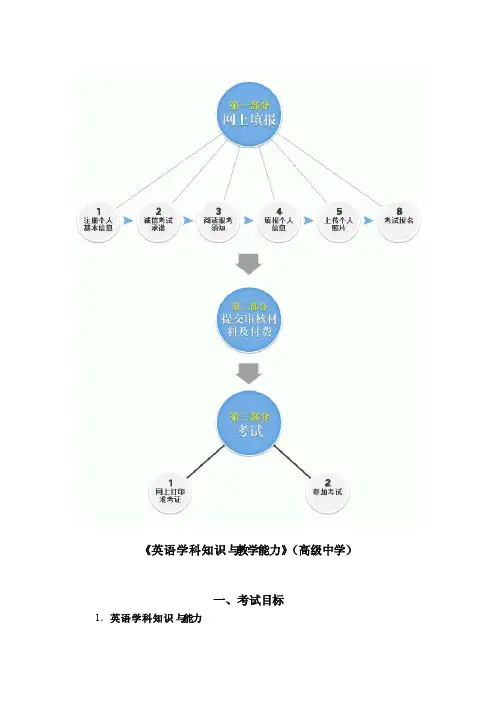
《英语学科知识与教学能力》(高级中学)一、考试目标1.英语学科知识与能力具有扎实的英语语言基础知识和语言能力;具备从事高中英语教学所需要的英语语言能力;能理解有关英语国家的语言、历史和文化等相关知识。
2.英语学科教学知识与能力掌握外语教学基本理论、英语教学专业知识与国家英语课程标准内容等学科教学知识,并能用以指导高中英语教学。
3.英语学科教学设计能力能够根据英语学科特点,针对高中学生的认知特点、语言水平和学习需要选择并设计合理的教学内容,形成完整合理的教学方案。
4.英语学科教学实施能力理解高中英语课堂教学实施的基本原则和方法,具备实施语言课堂教学的基本能力;能够根据教学设计,结合教学实际情况,采用恰当的教学手段,引导学生进行有效学习。
5.英语学科教学评价知识与能力了解高中英语课堂教学评价的基本知识和方法,能够对学生的语言学习进行恰当的评价;了解教学反思的基本方法和策略,能够对自己的课堂教学实践进行反思,提出改进的思路。
二、考试模块内容与要求(一)语言知识与能力1.掌握英语语言的基础知识,了解语言学研究中与语言教学相关的基本概念和知识,并能在课堂教学中加以运用。
2.具有良好的英语语言运用能力,包括用英语进行书面表达、获取教学资源和信息、表达思想情感和与学生良好沟通的能力;能够筛选并改编适合高中学生英语水平的语言材料。
3.能在语篇中理解英语国家的语言、历史和文学等相关的社会文化知识。
(二)语言教学知识与能力1.了解外语教学基本理论,理解语言观、语言学习观、语言教学观等对高中英语教学的指导作用。
2.理解国家颁布的英语学科课程标准的目标内容(语言技能、语言知识、情感态度、学习策略和文化意识),以及课程标准的其他相关知识,并能在教学设计与实施中运用。
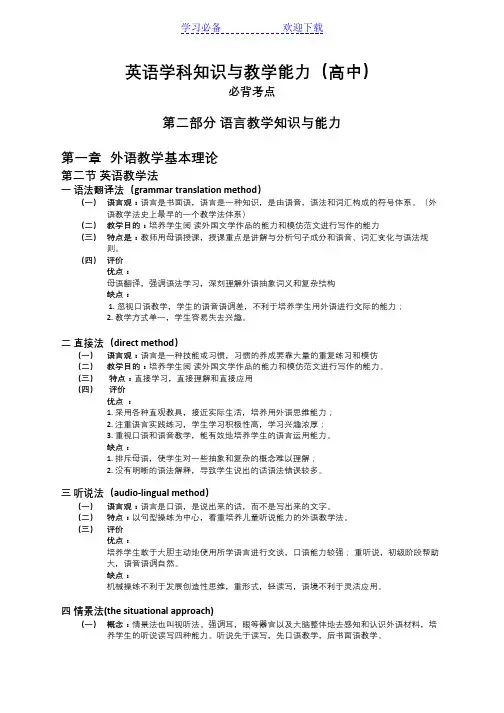
英语学科知识与教学能力(高中)必背考点第二部分语言教学知识与能力第一章外语教学基本理论第二节英语教学法一语法翻译法(grammar translation method)(一)语言观:语言是书面语,语言是一种知识,是由语音,语法和词汇构成的符号体系。
(外语教学法史上最早的一个教学法体系)(二)教学目的:培养学生阅读外国文学作品的能力和模仿范文进行写作的能力(三)特点是:教师用母语授课,授课重点是讲解与分析句子成分和语音、词汇变化与语法规则。
(四)评价优点:母语翻译,强调语法学习,深刻理解外语抽象词义和复杂结构缺点:1. 忽视口语教学,学生的语音语调差,不利于培养学生用外语进行交际的能力;2. 教学方式单一,学生容易失去兴趣。
二直接法(direct method)(一)语言观:语言是一种技能或习惯,习惯的养成要靠大量的重复练习和模仿(二)教学目的:培养学生阅读外国文学作品的能力和模仿范文进行写作的能力。
(三)特点:直接学习,直接理解和直接应用(四)评价优点:1. 采用各种直观教具,接近实际生活,培养用外语思维能力;2. 注重语言实践练习,学生学习积极性高,学习兴趣浓厚;3. 重视口语和语音教学,能有效地培养学生的语言运用能力。
缺点:1. 排斥母语,使学生对一些抽象和复杂的概念难以理解;2. 没有明晰的语法解释,导致学生说出的话语法错误较多。
三听说法(audio-lingual method)(一)语言观:语言是口语,是说出来的话,而不是写出来的文字。
(二)特点:以句型操练为中心,着重培养儿童听说能力的外语教学法。
(三)评价优点:培养学生敢于大胆主动地使用所学语言进行交谈,口语能力较强;重听说,初级阶段帮助大,语音语调自然。
缺点:机械操练不利于发展创造性思维,重形式,轻读写,语境不利于灵活应用。
四情景法(the situational approach)(一)概念:情景法也叫视听法。
强调耳,眼等器官以及大脑整体地去感知和认识外语材料,培养学生的听说读写四种能力。
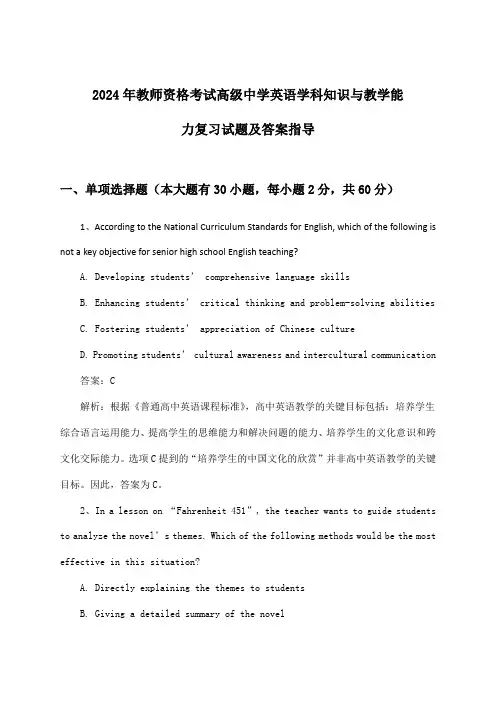
2024年教师资格考试高级中学英语学科知识与教学能力复习试题及答案指导一、单项选择题(本大题有30小题,每小题2分,共60分)1、According to the National Curriculum Standards for English, which of the following is not a key objective for senior high school English teaching?A. Developing students’ comprehensive language skillsB. Enhancing students’ critical thinking and problem-solving abilitiesC. Fostering students’ appreciation of Chinese cultureD. Promoting students’ cultural awareness and intercultural communication答案:C解析:根据《普通高中英语课程标准》,高中英语教学的关键目标包括:培养学生综合语言运用能力、提高学生的思维能力和解决问题的能力、培养学生的文化意识和跨文化交际能力。
选项C提到的“培养学生的中国文化的欣赏”并非高中英语教学的关键目标。
因此,答案为C。
2、In a lesson on “Fahrenheit 451”, the teacher wants to guide students to analyze the novel’s themes. Which of the following meth ods would be the most effective in this situation?A. Directly explaining the themes to studentsB. Giving a detailed summary of the novelC. Encouraging students to create their own summaries of the novel and discuss the themesD. Asking students to write a critical essay about the novel答案:C解析:在分析《 Fahrenheit 451》这部小说的主题时,教师应该鼓励学生主动参与,培养他们的批判性思维。
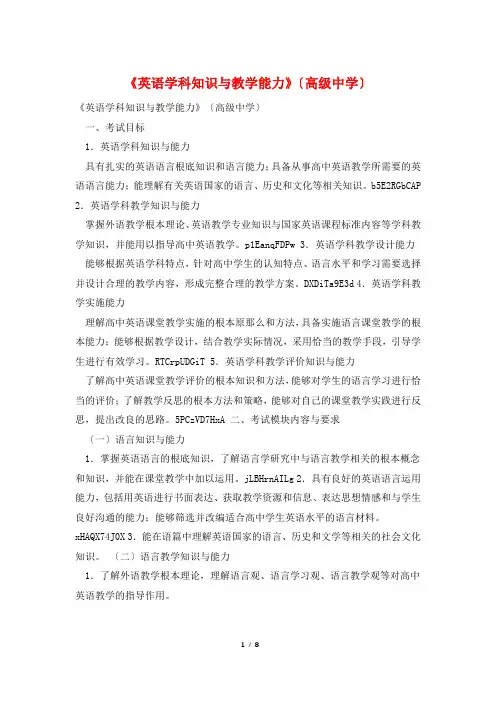
《英语学科知识与教学能力》〔高级中学〕《英语学科知识与教学能力》〔高级中学〕一、考试目标1.英语学科知识与能力具有扎实的英语语言根底知识和语言能力;具备从事高中英语教学所需要的英语语言能力;能理解有关英语国家的语言、历史和文化等相关知识。
b5E2RGbCAP 2.英语学科教学知识与能力掌握外语教学根本理论、英语教学专业知识与国家英语课程标准内容等学科教学知识,并能用以指导高中英语教学。
p1EanqFDPw 3.英语学科教学设计能力能够根据英语学科特点,针对高中学生的认知特点、语言水平和学习需要选择并设计合理的教学内容,形成完整合理的教学方案。
DXDiTa9E3d 4.英语学科教学实施能力理解高中英语课堂教学实施的根本原那么和方法,具备实施语言课堂教学的根本能力;能够根据教学设计,结合教学实际情况,采用恰当的教学手段,引导学生进行有效学习。
RTCrpUDGiT 5.英语学科教学评价知识与能力了解高中英语课堂教学评价的根本知识和方法,能够对学生的语言学习进行恰当的评价;了解教学反思的根本方法和策略,能够对自己的课堂教学实践进行反思,提出改良的思路。
5PCzVD7HxA 二、考试模块内容与要求〔一〕语言知识与能力1.掌握英语语言的根底知识,了解语言学研究中与语言教学相关的根本概念和知识,并能在课堂教学中加以运用。
jLBHrnAILg 2.具有良好的英语语言运用能力,包括用英语进行书面表达、获取教学资源和信息、表达思想情感和与学生良好沟通的能力;能够筛选并改编适合高中学生英语水平的语言材料。
xHAQX74J0X 3.能在语篇中理解英语国家的语言、历史和文学等相关的社会文化知识。
〔二〕语言教学知识与能力1.了解外语教学根本理论,理解语言观、语言学习观、语言教学观等对高中英语教学的指导作用。
2.理解国家公布的英语学科课程标准的目标内容〔语言技能、语言知识、情感态度、1 / 6学习策略和文化意识〕,以及课程标准的其他相关知识,并能在教学设计与实施中运用。
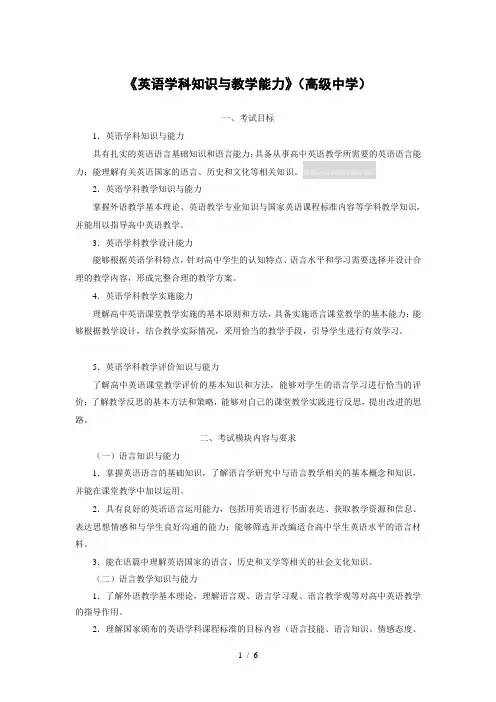
《英语学科知识与教学能力》(高级中学)一、考试目标1.英语学科知识与能力具有扎实的英语语言基础知识和语言能力;具备从事高中英语教学所需要的英语语言能力;能理解有关英语国家的语言、历史和文化等相关知识。
矚慫润厲钐瘗睞枥庑赖。
2.英语学科教学知识与能力掌握外语教学基本理论、英语教学专业知识与国家英语课程标准内容等学科教学知识,并能用以指导高中英语教学。
3.英语学科教学设计能力能够根据英语学科特点,针对高中学生的认知特点、语言水平和学习需要选择并设计合理的教学内容,形成完整合理的教学方案。
4.英语学科教学实施能力理解高中英语课堂教学实施的基本原则和方法,具备实施语言课堂教学的基本能力;能够根据教学设计,结合教学实际情况,采用恰当的教学手段,引导学生进行有效学习。
5.英语学科教学评价知识与能力了解高中英语课堂教学评价的基本知识和方法,能够对学生的语言学习进行恰当的评价;了解教学反思的基本方法和策略,能够对自己的课堂教学实践进行反思,提出改进的思路。
二、考试模块内容与要求(一)语言知识与能力1.掌握英语语言的基础知识,了解语言学研究中与语言教学相关的基本概念和知识,并能在课堂教学中加以运用。
2.具有良好的英语语言运用能力,包括用英语进行书面表达、获取教学资源和信息、表达思想情感和与学生良好沟通的能力;能够筛选并改编适合高中学生英语水平的语言材料。
3.能在语篇中理解英语国家的语言、历史和文学等相关的社会文化知识。
(二)语言教学知识与能力1.了解外语教学基本理论,理解语言观、语言学习观、语言教学观等对高中英语教学的指导作用。
2.理解国家颁布的英语学科课程标准的目标内容(语言技能、语言知识、情感态度、学习策略和文化意识),以及课程标准的其他相关知识,并能在教学设计与实施中运用。
3.掌握英语语言知识(语音、词汇、语法、语篇等)的教学基本原则、讲解和练习方法。
4.掌握英语语言技能(听、说、读、写)教学的基本原则和训练方法。
《英语学科知识与教学能力》(高级中学)一、考试目标1.英语学科知识与能力具有扎实的英语语言基础知识和语言能力;具备从事高中英语教学所需要的英语语言能力;能理解有关英语国家的语言、历史和文化等相关知识。
2.英语学科教学知识与能力掌握外语教学基本理论、英语教学专业知识与国家英语课程标准内容等学科教学知识,并能用以指导高中英语教学。
3.英语学科教学设计能力能够根据英语学科特点,针对高中学生的认知特点、语言水平和学习需要选择并设计合理的教学内容,形成完整合理的教学方案。
4.英语学科教学实施能力理解高中英语课堂教学实施的基本原则和方法,具备实施语言课堂教学的基本能力;能够根据教学设计,结合教学实际情况,采用恰当的教学手段,引导学生进行有效学习。
5.英语学科教学评价知识与能力了解高中英语课堂教学评价的基本知识和方法,能够对学生的语言学习进行恰当的评价;了解教学反思的基本方法和策略,能够对自己的课堂教学实践进行反思,提出改进的思路。
二、考试模块内容与要求(一)语言知识与能力1.掌握英语语言的基础知识,了解语言学研究中与语言教学相关的基本概念和知识,并能在课堂教学中加以运用。
2.具有良好的英语语言运用能力,包括用英语进行书面表达、获取教学资源和信息、表达思想情感和与学生良好沟通的能力;能够筛选并改编适合高中学生英语水平的语言材料。
3.能在语篇中理解英语国家的语言、历史和文学等相关的社会文化知识。
(二)语言教学知识与能力1.了解外语教学基本理论,理解语言观、语言学习观、语言教学观等对高中英语教学的指导作用。
2.理解国家颁布的英语学科课程标准的目标内容(语言技能、语言知识、情感态度、学习策略和文化意识),以及课程标准的其他相关知识,并能在教学设计与实施中运用。
3.掌握英语语言知识(语音、词汇、语法、语篇等)的教学基本原则、讲解和练习方法。
4.掌握英语语言技能(听、说、读、写)教学的基本原则和训练方法。
5.能结合中外社会文化语境,设计并实施英语知识和技能的教学与训练。
《英语学科知识与教学能力》(高级中学)一、考试目标1.英语学科知识与能力具有扎实的英语语言基础知识和语言能力;具备从事高中英语教学所需要的英语语言能力;能理解有关英语国家的语言、历史和文化等相关知识。
2.英语学科教学知识与能力掌握外语教学基本理论、英语教学专业知识与国家英语课程标准内容等学科教学知识,并能用以指导高中英语教学。
3.英语学科教学设计能力能够根据英语学科特点,针对高中学生的认知特点、语言水平和学习需要选择并设计合理的教学内容,形成完整合理的教学方案。
4.英语学科教学实施能力理解高中英语课堂教学实施的基本原则和方法,具备实施语言课堂教学的基本能力;能够根据教学设计,结合教学实际情况,采用恰当的教学手段,引导学生进行有效学习。
5.英语学科教学评价知识与能力了解高中英语课堂教学评价的基本知识和方法,能够对学生的语言学习进行恰当的评价;了解教学反思的基本方法和策略,能够对自己的课堂教学实践进行反思,提出改进的思路。
二、考试模块内容与要求(一)语言知识与能力1.掌握英语语言的基础知识,了解语言学研究中与语言教学相关的基本概念和知识,并能在课堂教学中加以运用。
2.具有良好的英语语言运用能力,包括用英语进行书面表达、获取教学资源和信息、表达思想情感和与学生良好沟通的能力;能够筛选并改编适合高中学生英语水平的语言材料。
3.能在语篇中理解英语国家的语言、历史和文学等相关的社会文化知识。
(二)语言教学知识与能力1.了解外语教学基本理论,理解语言观、语言学习观、语言教学观等对高中英语教学的指导作用。
2.理解国家颁布的英语学科课程标准的目标内容(语言技能、语言知识、情感态度、学习策略和文化意识),以及课程标准的其他相关知识,并能在教学设计与实施中运用。
3.掌握英语语言知识(语音、词汇、语法、语篇等)的教学基本原则、讲解和练习方法。
4.掌握英语语言技能(听、说、读、写)教学的基本原则和训练方法。
5.能结合中外社会文化语境,设计并实施英语知识和技能的教学与训练。
2024年教师资格考试高级中学英语学科知识与教学能力复习试题及答案指导一、单项选择题(本大题有30小题,每小题2分,共60分)1、Which of the following activities is most suitable for developing students’ listening skills for specific information?A)Listening to a song and discussing its themeB)Participating in a debate on a current issueC)Completing a chart with details from a news reportD)Role-playing a conversation at a restaurantAnswer: C) Completing a chart with details from a news reportExplanation: This activity requires students to listen for and extract specific pieces of information, which is a key skill in listening comprehension. It helps train them to focus on particular details within a larger context, such as numbers, dates, or other factual data, that might be part of a news broadcast. Other options, while valuable, do not specifically target the skill of listening for detailed information.2、When designing a reading lesson, what is the primary purpose ofpre-reading activities?A)To practice grammar and vocabulary related to the textB)To introduce the topic and activate prior knowledgeC)To summarize the main points of the textD)To assess students’ comprehension after readingAnswer: B) To introduce the topic and activate prior knowledgeExplanation: Pre-reading activities are crucial for setting the stage for successful reading. They help to engage students with the topic, stimulate interest, and connect the new material to what they already know, thereby facilitating better understanding and retention. While practicing grammar and vocabulary can be beneficial, it is typically more aligned with during- or post-reading stages. Summarizing the main points and assessing comprehension are generally done after the reading has taken place.3、The sentence “The book is as interesting as a movie.” is an example of which figure of speech?A)HyperboleB)SimileC)MetaphorD)AlliterationAnswer: B) SimileExplanation: A simile is a figure of speech that compares two different things, typically using “as” or “like.” In this sentence, “as interesting as a movie” is comparing the book’s interest level to that of a movie.4、In the following sentence, “She sang beautifully,” the word “beautifully” is an example of what part of speech?A)VerbB)AdverbC)NounD)AdjectiveAnswer: B) AdverbExplanation: An adverb modifies verbs, adjectives, or other adverbs. In this sentence, “beautifully” modifies the verb “sang,” indicating how well she sang.5、Which of the following sentences correctly uses the passive voice?A) The book was read by Sarah.B) Sarah reads the book.C) The book read by Sarah.D) Sarah has been reading the book.Answer: A) The book was read by Sarah.Explanation: In this question, we are looking for the sentence that correctly uses the passive voice. The passive voice construction involves using a form of the verb ‘to be’ with the past participle of the main verb. Option A is correct because it uses ‘was read’, which is the past passive form of the verb ‘read’. The other options either use active voice (B and D) or have incomplete structure (C).6、What type of word formation process is illustrated in the creation of the word “unbelievable” from “believe”?A) ConversionB) CompoundingC) AffixationD) BlendingAnswer: C) AffixationExplanation: The term “unbelievable” is formed by adding the prefix “un-” and the suffix “-able” to the base word “believe.” This process of word formation, where affixes (prefixes or suffixes) are added to a root word to create new words, is known as affixation. Conversion refers to changing a word from one part of speech to another without changing the form of the word, compounding involves combining two or more words to create a new word, and blending is the process of creating a new word by merging parts of two existing words.7、The following sentence contains a verb that is in the passive voice. Which one is it?A. The book is being read by the students.B. The students are reading the book.C. The book reads by the students.D. The students read the book.Answer: AExplanation: The sentence in the p assive voice is “The book is being read by the students.” In the passive voice, the focus is on the action being done to the subject, which in this case is “the book.” The subject “the book” is being acted upon by the students.8、Choose the word that best completes the following sentence:The teacher__________the students to work in groups to complete the project.A. requiredB. permittedC. recommendedD. requestedAnswer: DExplanation: The correct word to complete the sentence is “requested.” This is bec ause “request” is a polite way of asking for something, which is appropriate in the context of a teacher asking students to work in groups. “Required” implies a mandatory action, “permitted” implies allowing something to happen, and “recommended” implies g iving a suggestion.9、Which of the following sentences correctly uses the subjunctive mood to express a wish or a hypothetical situation?A) If only I were younger, I could enjoy playing sports more.B) If he was here, he would help us.C) She wishes that she is at home.D) They demanded that the meeting will be postponed.Answer: A) If only I were younger, I could enjoy playing sports more.Explanation: The subjunctive mood is used to express wishes, suggestions, or situations that are contrary to fact or are unlikely to happen. In option A, “were” is the correct form to use in a wish clause, and “could” properlyexpresses a hypothetical situation.10、Choose the sentence that correctly demonstrates the use of a reported speech (indirect speech).A) He said, “I have already completed my homework.”B) She exclaimed, “This book is fascinating!”C) They asked if we had seen their lost cat.D) She asked me, “Are you coming to the party tonight?”Answer: C) They asked if we had seen their lost cat.Explanation: Reported speech (also known as indirect speech) involves reporting what someone else has said without using their exact words. In option C, the original direct question “Have you seen our lost cat?” is transformed into an indirect question “if we had seen their lost cat,” which is grammatically correct when reporting the speech.11.The sentence “The book is easy to read, but difficult to understand.” can be best paraphrased as:A)The book is readable, but comprehension is challenging.B)The book is easy, but it’s hard to grasp its meaning.C)The book is simple to read, but complex in its content.D)It’s simple to read the book, but it’s tough to understand it.Answer: AExplanation: Option A maintains the original meaning by using synonyms for “easy” (readable) and “difficult” (challenging) while keeping the structure of the sentence similar. The other options change the sentence structure or useslightly different meanings that do not convey the same idea as the original sentence.12.Which of the following phrases is most appropriate to use when addressinga group of students during a lesson?A)“Class, please pay attention to the board.”B)“Ladies and gentlemen, I need your full attention.”C)“Boys and girls, let’s begin with the next activity.”D)“Good afternoon, students, let’s move on to the exercise.”Answer: AExplanation: Option A is the most appropriate because it directly addresses the class and requests their attention, which is common practice in a classroom setting. Options B and D are too formal and may come across as unnecessary, while option C focuses on the activity rather than the immediate need for attention.13、Which of the following is NOT a characteristic of Communicative Language Teaching (CLT)?A)Focusing on fluency over accuracyB)Emphasizing the use of authentic materialsC)Encouraging learner autonomyD)Prioritizing the teaching of grammatical structures in isolationAnswer: D) Prioritizing the teaching of grammatical structures in isolationExplanation: Communicative Language Teaching (CLT) emphasizes the importance of meaningful communication and the functional use of language. It encourages fluency and the use of authentic materials to simulate real-lifesituations. CLT also supports the development of learner autonomy by allowing students to take an active role in their learning process. The teaching of grammatical structures in isolation, which focuses on form rather than meaning or function, is not a typical feature of CLT and is more characteristic of traditional, teacher-centered approaches to language instruction.14、When designing a reading comprehension task, what is the most important factor to consider in order to ensure that the task is effective and engaging for high school students?A)The length of the textB)The relevance of the content to students’ interests and experiencesC)The complexity of the vocabulary used in the textD)The inclusion of pictures and diagramsAnswer: B) The relevance of the content to students’ interests and experiencesExplanation: To create an effective and engaging reading comprehension task, it’s crucial that the content resonates with the students’ own lives and interests. This connection can motivate them to read more closely and critically. While the length of the text, the complexity of the vocabulary, and visual aids such as pictures and diagrams can all play a role in the design of a good reading task, they are secondary to the relevance of the content. When students find the material relevant, they are more likely to be invested in understanding and analyzing the text, thus enhancing their comprehension skills and overall engagement with the subject matter.15.The sentence “He is a teacher who always encourages his students toexpress their opinions freely.” is a n example of a sentence that demonstrates which of the following teaching principles?A. ConformityB. AuthorityC. EncouragementD. AutonomyAnswer: C. EncouragementExplanation: This question tests the understanding of teaching principles. The sentence describes a teacher who encourages students to freely express their opinions, which is an example of the “Encouragement” principle. Conformity and Authority are teaching styles that do not necessarily involve encouraging free expression, while Autonomy is a student-centered approach that focuses on giving students the freedom to learn independently, which is not explicitly mentioned in the sentence.16.Which of the following is the most appropriate method to use when introducing a new topic to advanced English language learners?A. Direct translationB. Telling the storyC. Showing a related videoD. Using a vocabulary listAnswer: C. Showing a related videoExplanation: This question assesses the candidate’s knowledge ofappropriate teaching methods for different levels of English language learners. Advanced learners often benefit from multimedia resources to enhance their understanding. Showing a related video (Option C) can provide visual and auditory input, which can be more engaging and effective for advanced learners compared to direct translation (Option A), telling a story (Option B), or using a vocabulary list (Option D), which may be less engaging or not provide the necessary context for understanding.17、Which of the following best describes the role of formative assessment in an English language classroom?A. To rank students based on their performanceB. To provide feedback that can be used to improve teaching and learningC. To assign final grades at the end of the termD. To determine which students should be promotedAnswer: B. To provide feedback that can be used to improve teaching and learning.Explanation: Formative assessment is an ongoing process used by all teachers and students. It involves collecting evidence of learning during the learning process for the purposes of improving teaching and learning and focuses on the development of students’ linguistic competence.18、When teaching reading comprehension, which strategy would be most effective in helping students understand the main idea of a text?A. Focusing solely on vocabulary expansionB. Encouraging rote memorization of the textC. Discussing the text’s context and summarizing its key pointsD. Translating the text word-for-word into the students’ native languageAnswer: C. Discussing the text’s context and summarizing its key points.Explanation: Effective reading comprehension strategies involve helping students grasp the main ideas and themes of a text, rather than just focusing on vocabulary or translating word-for-word. By discussing the context and summarizing key points, students are better able to comprehend and retain the overall message of the text.19.In the following sentence, “The students were eagerly waiting for the teacher to arrive,” which word is an adverb?A. eagerlyB. waitingC. teacherD. arriveAnswer: AExplanation: The word “eagerly” is an adverb that modifies the verb “waiting,” indicating the manner in which the students were waiting.20.Which of the following phrases is an example of a present perfect continuous tense?A. He has just finished his homework.B. She is reading a book.C. They went to the park yesterday.D. I have eaten breakfast.Answer: AExplanation: Th e phrase “He has just finished his homework” is in the present perfect continuous tense, which is used to describe an action that started in the past and is still continuing at the present moment. The other options do not fit this tense structure.21.The following sentence is an example of a_______clause.A. restrictiveB. non-restrictiveC. relativeD. adverbialAnswer: CExplanation: The sentence “The book that you gave me is very interesting.” contains a relative clause that provides additional information about the noun “book.” Relative clauses are used to define or give more information about a noun, and they are introduced by relative pronouns or adverbs such as “who,” “which,” “that,” and “where.”22.In the sentence “She has a lot of experience in teaching English,” the word “a lot of” is used to express:A. timeB. amountC. qualityD. conditionAnswer: BExplanation: “A lot of” is a colloquial expression used to indicate a large amount or number of something. In this sentence, it is used to express the large amount of experience the subject has in teaching English. Therefore, the correct answer is “amount.”23.The following sentence contains an error in punctuation. Which one is it?A. She is a teacher, who teaches English at a high school.B. She is a teacher, who teaches English; she teaches at a high school.C. She is a teacher; she teaches English, and she teaches at a high school.D. She is a teacher, who teaches English at a high school; she is dedicated to her work.Answer: BExplanation: The correct answer is B because it uses a semicolon to connect two independent clauses, “who teaches English” and “she teaches at a high school.” The other options either lack proper punctuation or separate the two clauses with a comma, which is incorrect when used with independent clauses.24.Which of the following is an example of a cohesive device used in the following sentence?“The students were excited to learn new vocabulary, and they eagerlyparticipated in class discussions.”A. RepetitionB. CoherenceC. TransitionD. EllipsisAnswer: CExplanation: The correct answer is C, “Transition.” The word “and” serves as a transition word that connects two related ideas in the sentence. Repetition involves using the same words or phrases, coherence refers to the overall logical structure of the text, and ellipsis indicates the omission of words or phrases.25.The following sentence contains a sentence error. Which one is it?A. The teacher emphasized the importance of learning English through practice.B. It was after midnight that she realized she had left her keys at home.C. The more we practice, the better we become at speaking English.D. He not only teaches English but also coaches the school’s soccer team.Answer: DExplanation: The error in the sentence is the use of “not only … but also” with inversion, which is not necessary in this context. The correct sentence should be “He teaches English and coaches the school’s soccer team.” Therefore, the correct answer is D.26.Choose the word that does not belong to the following list:A. curriculumB. syllabusC. textbookD. worksheetE. classroomAnswer: EExplanation: The words “curriculum,” “syllabus,” “textbook,” and “worksheet” all relate to teaching materials and educational content. “Classroom,” on the other hand, refers to the physical space where teaching takes place. Therefore, “classroom” does not belong to the list, and the correct answer is E.27.The following sentence is correctly punctuated:A) He asked, “How are you doing?”B) He asked “How are you doing?”C) He asked: “How are you doing?”D) He asked; “How are you doing?”Answer: C)Explanation: The correct form of a direct question within a sentence is to use quotation marks and a comma after the question mark. Therefore, option C is the correct choice.28.Which of the following is an example of a simile?A) The wind howled like a wolf.B) The wind was cold and sharp.C) The wind was a terrible storm.D) The wind was so strong, it blew down the trees.Answer: A)Explanation: A simile is a figure of speech that compares two different things using “like” or “as.” Option A uses “like” to compare t he sound of the wind to that of a wolf, making it the correct answer. Options B, C, and D are descriptions but do not use the comparison form of a simile.29.In the following sentence, “The teacher’s enthusiasm was infectious,” which word best describes th e teacher’s behavior?A. MotivationalB. DiscouragingC. AnnoyingD. ImpersonalAnswer: A. MotivationalExplanation: The word “infectious” suggests that the teacher’s enthusiasm was so strong that it could spread to others, which implies a motivational behavior.30.Which of the following is an effective teaching strategy for introducinga new topic in an English lesson?A. Asking students to write their own definitions of the new vocabularywords.B. Telling students the definition of the new vocabulary words and moving on.C. Showing a video related to the new topic without any explanation.D. Reading the text to the students and asking them to follow along.Answer: A. Asking students to write their own definitions of the new vocabulary words.Explanation: Encouraging students to create their own definitions helps them to engage with the new vocabulary actively and promotes critical thinking. This strategy can also help students remember the words better.二、简答题(20分)Question:Explain the importance of vocabulary development in the English language teaching process and how teachers can effectively promote vocabulary learning in high school students.Answer:Vocabulary development plays a crucial role in the English language teaching process as it enhances stud ents’ overall language proficiency. Here are some key reasons for its importance:munication: A rich vocabulary allows students to express their thoughts and ideas more effectively, leading to better communication skills.prehension: Having a wide range of vocabulary enables students tounderstand and interpret texts more accurately.3.Academic success: Vocabulary knowledge is essential for academic success, as it helps students in reading, writing, and comprehending complex texts.4.Critical thinking: A diverse vocabulary aids in critical thinking and problem-solving skills as it allows students to analyze and evaluate information more effectively.To promote vocabulary learning effectively, teachers can employ the following strategies:1.Introduce new vocabulary through context: Present new words in meaningful contexts to help students understand their meaning and usage.e visual aids and realia: Incorporate visual aids, such as pictures, videos, and real objects, to make vocabulary learning more engaging and memorable.3.Encourage active learning: Engage students in activities like games, discussions, and role-playing to reinforce vocabulary learning.4.Provide opportunities for repetition: Use repetition in various forms, such as through songs, chants, and flashcards, to reinforce vocabulary learning.5.Assess vocabulary knowledge: Regularly assess students’ vocabulary knowledge through quizzes, tests, and oral presentations.6.Integrate vocabulary into all aspects of language teaching: Incorporate vocabulary into reading, writing, speaking, and listening activities to ensure comprehensive learning.e technology: Utilize educational apps, online resources, andmultimedia tools to make vocabulary learning more interactive and engaging.By implementing these strategies, teachers can effectively promote vocabulary learning in high school students, ultimately contributing to their overall language development.三、教学情境分析题(30分)Question: Teaching Scenario AnalysisScenario:In your secondary school English class, you have just completed a unit on “Exploring Cultural Differences”. The students have shown i nterest in the topic, but you notice that some of them are struggling to engage with the material, particularly when it comes to discussing cultural norms and values. The class consists of diverse students from various cultural backgrounds.Task:Analyze the teaching scenario described above and suggest appropriate strategies to improve student engagement and understanding of the material.Answer:Strategies to Improve Student Engagement and Understanding:1.Interactive Group Discussions:•Divide the class into small groups, each with students from different cultural backgrounds.•Assign each group a specific cultural norm or value to research anddiscuss.•Encourage students to share their own experiences and perspectives, fostering a collaborative learning environment.2.Cultural Exchange Activities:•Organize a “Cultural Day” where students can bring in items or artifacts that represent their own culture.•Have students create presentations or posters about their cultural norms and values.•This activity allows students to learn from each other’s experiences and promotes a deeper understanding of cultural diversity.3.Real-World Connection:•Integrate real-life examples and case studies that illustrate the impact of cultural differences in different contexts.•Use videos, news articles, or literature that explore cultural conflicts or misunderstandings.•This helps students connect the theoretical concepts to real-world situations.4.Critical Thinking Questions:•Pose thought-provoking questions that encourage students to analyze and evaluate different cultural norms and values.•Questions could include: “How might cultural differences affect international business negotiations?” or “What are the potential challenges of living in a culturally diverse society?”5.Role-Playing Exercises:•Create role-playing scenarios where students act out different cultural interactions.•This activity allows students to practice communication skills and understand the nuances of cultural differences in a controlled setting.Explanation:The suggested strategies aim to address the issues of student engagement and understanding in the given scenario. By implementing interactive group discussions, cultural exchange activities, real-world connections, critical thinking questions, and role-playing exercises, the teacher can create a more inclusive and dynamic learning environment. These activities not only encourage students to actively participate but also help them develop empathy, cultural awareness, and critical thinking skills.四、教学设计题(40分)Teaching Design QuestionQuestion:Design a 45-minute lesson plan for a senior high school English class aimed at teaching the theme of “Global Warming” to students. The class consists of 30 students with diverse English proficiency levels. The lesson should include an introduction, a main activity, and a conclusion. Ensure that the lesson incorporates interactive activities, vocabulary building, and grammarpractice.Answer:Lesson Title: “Global Warming: Causes and Solutions”Target Language Skills: Reading, Speaking, Listening, and WritingMaterials:1.Handouts with articles on global warming (one for each student)2.Whiteboard and markers3.Projector and laptop for presentations4.Vocabulary cards5.Group activity handouts6.Writing paperIntroduction (10 minutes):1.Start the class by asking students about their knowledge of global warming. Encourage them to share what they know.2.Show a brief video clip on global warming (e.g., National Geographic documentary) to introduce the topic.3.Summarize the main points from the video and introduce the lesson objectives.Main Activity (25 minutes):1.Divide the class into small groups of 5-6 students.2.Distribute handouts with articles on global warming to each student.3.Instruct each group to read their articles and identify the causes and solutions for global warming.4.Conduct a group discussion, where each group presents their findings to the class. Encourage other students to ask questions and participate in the discussion.5.While groups are presenting, use the vocabulary cards to introduce new terms related to global warming.6.After all groups have presented, ask students to identify the main causes and solutions for global warming.Grammar Practice (5 minutes):1.Introduce the present perfect tense, which is commonly used to describe actions that started in the past and continue to the present or have a present result.2.Provide a brief example sentence and have students practice forming sentences using the present perfect tense.3.Pair students up and have them ask each other questions about global warming, using the present perfect tense.Conclusion (5 minutes):1.Summarize the main points of the lesson, emphasizing the causes and solutions for global warming.2.Ask students to share their thoughts on the topic and discuss what they can do to contribute to solving the problem.3.Assign a writing task: Students should write a short essay (150-200 words) on how they can personally contribute to reducing global warming.Evaluation:•Observe students’ participation in group discussions and presentations.•Assess students’ understanding of the vocabulary and grammar concepts.•Evaluate the quality of the essays written for the conclusion activity.Explanation:The lesson plan incorporates a variety of activities, such as reading, speaking, listening, and writing, to cater to different learning styles. The use of group discussions and presentations encourages students to actively engage with the topic and develop their critical thinking skills. The inclusion of vocabulary cards and grammar practice ensures that students build their language skills while learning about global warming. The writing task at the end of the lesson reinforces the main concepts and encourages students to reflect on their personal contributions to the issue.。
2022年下半年教师资格证考试《英语学科知识与教学能力》(高级中学)真题及答案(回忆版)第1题单项选择题(每题2分,共30题,共60分)下列每小题的四个选项中,只有一项是最符合题意的正确答案,多选、错选或不选均不得分。
1、The final of the word “s ”is not pronounced.()A、debrisB、waresC、****D、appropriates【参考答案】A【参考解析】debris发音[ˈdebriː],s不发音,故选A。
2、What is the difference between English vowels and consonants? ()A、Psits of the****B、Obstruction of the air.C、****D、Movement of **lips.【参考答案】B【参考解析】元音和辅音的区别是在于发元音时气流在通道不受阻碍, 而发辅音时气流在通道上受阻。
故选B。
3、We have invited ****people to attend my daughter's wedding()A、***sogetherB、altogetherC、togetherD、together al!【参考答案】B【参考解析】4、you can*****see the of longitude and latitude in a map()A、linesB、bordersC、boundariesD、frontiers【参考答案】A【参考解析】5、That **** performance by Larry last night enthusiastic applause of the audience. ()A、** inEACHHTEB、drew forthC、won overD、won up【参考答案】B【参考解析】6、The interview success rate by language*** did not differ notably,was ***much difference ** the success rate by job type()A、norB、***C、neitherD、or【参考答案】A【参考解析】7、He wasn't appointed chairman of the committee, not very****popular with all its members. ()A 、to consideredB、being consideredC、beny consideredD、having considered【参考答案】B【参考解析】句子翻译为:他没有被任命为这个委员会的主席,因为在所有的成员中并不是那么受欢迎。
《英语学科知识与教学能力》(高级中学)一、考试目标1.英语学科知识与能力具有扎实的英语语言基础知识和语言能力;具备从事高中英语教学所需要的英语语言能力;能理解有关英语国家的语言、历史和文化等相关知识。
2.英语学科教学知识与能力掌握外语教学基本理论、英语教学专业知识与国家英语课程标准内容等学科教学知识,并能用以指导高中英语教学。
3.英语学科教学设计能力能够根据英语学科特点,针对高中学生的认知特点、语言水平和学习需要选择并设计合理的教学内容,形成完整合理的教学方案。
4.英语学科教学实施能力理解高中英语课堂教学实施的基本原则和方法,具备实施语言课堂教学的基本能力;能够根据教学设计,结合教学实际情况,采用恰当的教学手段,引导学生进行有效学习。
5.英语学科教学评价知识与能力了解高中英语课堂教学评价的基本知识和方法,能够对学生的语言学习进行恰当的评价;了解教学反思的基本方法和策略,能够对自己的课堂教学实践进行反思,提出改进的思路。
二、考试模块内容与要求(一)语言知识与能力1.掌握英语语言的基础知识,了解语言学研究中与语言教学相关的基本概念和知识,并能在课堂教学中加以运用。
2.具有良好的英语语言运用能力,包括用英语进行书面表达、获取教学资源和信息、表达思想情感和与学生良好沟通的能力;能够筛选并改编适合高中学生英语水平的语言材料。
3.能在语篇中理解英语国家的语言、历史和文学等相关的社会文化知识。
(二)语言教学知识与能力1.了解外语教学基本理论,理解语言观、语言学习观、语言教学观等对高中英语教学的指导作用。
2.理解国家颁布的英语学科课程标准的目标内容(语言技能、语言知识、情感态度、学习策略和文化意识),以及课程标准的其他相关知识,并能在教学设计与实施中运用。
3.掌握英语语言知识(语音、词汇、语法、语篇等)的教学基本原则、讲解和练习方法。
4.掌握英语语言技能(听、说、读、写)教学的基本原则和训练方法。
5.能结合中外社会文化语境,设计并实施英语知识和技能的教学与训练。
《英语学科知识与教学能力》(高级中学)一、考试目标1.英语学科知识与能力具有扎实的英语语言基础知识和语言能力;具备从事高中英语教学所需要的英语语言能力;能理解有关英语国家的语言、历史和文化等相关知识。
2.英语学科教学知识与能力掌握外语教学基本理论、英语教学专业知识与国家英语课程标准内容等学科教学知识,并能用以指导高中英语教学。
3.英语学科教学设计能力能够根据英语学科特点,针对高中学生的认知特点、语言水平和学习需要选择并设计合理的教学内容,形成完整合理的教学方案。
4.英语学科教学实施能力理解高中英语课堂教学实施的基本原则和方法,具备实施语言课堂教学的基本能力;能够根据教学设计,结合教学实际情况,采用恰当的教学手段,引导学生进行有效学习。
5.英语学科教学评价知识与能力了解高中英语课堂教学评价的基本知识和方法,能够对学生的语言学习进行恰当的评价;了解教学反思的基本方法和策略,能够对自己的课堂教学实践进行反思,提出改进的思路。
二、考试模块内容与要求(一)语言知识与能力1.掌握英语语言的基础知识,了解语言学研究中与语言教学相关的基本概念和知识,并能在课堂教学中加以运用。
2.具有良好的英语语言运用能力,包括用英语进行书面表达、获取教学资源和信息、表达思想情感和与学生良好沟通的能力;能够筛选并改编适合高中学生英语水平的语言材料。
3.能在语篇中理解英语国家的语言、历史和文学等相关的社会文化知识。
(二)语言教学知识与能力1.了解外语教学基本理论,理解语言观、语言学习观、语言教学观等对高中英语教学的指导作用。
2.理解国家颁布的英语学科课程标准的目标内容(语言技能、语言知识、情感态度、学习策略和文化意识),以及课程标准的其他相关知识,并能在教学设计与实施中运用。
3.掌握英语语言知识(语音、词汇、语法、语篇等)的教学基本原则、讲解和练习方法。
4.掌握英语语言技能(听、说、读、写)教学的基本原则和训练方法。
5.能结合中外社会文化语境,设计并实施英语知识和技能的教学与训练。
(三)教学设计1.了解高中学生的认知特点、已有的英语知识、语言能力和学习需求,能够说明教学内容与学生已学知识之间的联系。
2.理解课程标准的目标要求,能够根据学生的特点选择恰当的教学内容。
3.能够根据教学内容和学生特点设定合理、明确与具体的教学目标。
4.能够根据教学目标创设相应的教学情景,设计有效的教学活动,安排合理的教学过程,筛选适当的辅助教学材料。
5.能够根据教学内容和教学过程,设计有效的学习评估活动。
(四)教学实施与评价1.掌握英语课堂教学的基本步骤与方法,能够创设教学情景,激发学习动机,引导学生参与语言学习活动。
2.掌握指导学生学习的方法和策略,能依据英语学科和学生的特点,根据教学实际情况,恰当地运用语言讲解、练习、提问、反馈等方法,帮助学生有效学习。
3.掌握课堂管理的基本方法,熟悉课堂活动的常用组织形式,能在教学活动中以学生为中心组织教学,能在课堂教学的不同阶段发挥教师的作用。
4.掌握课堂总结的方法,能适时地对教学内容进行归纳、总结与评价,科学合理地布置作业。
5.掌握基本的现代教育技术,能够针对不同的教学内容与教学目标,整合多种资源,选择恰当的辅助教学手段进行有效教学。
6.了解形成性评价和终结性评价的知识与方法,并在高中英语教学中合理运用。
7.了解教学案例评析的基本方法,能够对教学案例进行评价。
8.了解教学反思的基本方法和策略,能够对自己的教学进行反思并提出改进思路。
三、试卷结构四、题型示例I.语言知识与能力1.单项选择题(语言知识)(1)Thousands of ex-army officers have found _________ jobs in private security firms in the US.A.lucrative B.ludicrousC.longish D.lucky(2)The manager persuaded the team to play the game. What actually happened according to this statementA.The manager played hard.B.The team played hard.C.The team actually did not play.D.The manager actually did not play.2.单项选择题(阅读理解)Human beings are an irritant to Mother Nature, and in spite of the fact that it took their brains five million years toevolve, She can rid Herself of them in an instant. This, however, may not be necessary, since humans seem to be racing to see if they can save Her the trouble. They behave so arrogantly, contending they are superior to Nature. Rain forests are being cut down or burned—not only polluting the air but also causing a drop in oxygen levels. The love affair people have with their automobiles, especially “gas hog” SUV’s, adds to the pollutants in the air and is, yet, another nail in their coffins. Since prehistoric times, humans have been stalking and killing animals, causing many, beginning with the mastodon and saber-toothed tiger, to become extinct. Modern civilization is rushing headlong to slaughter animals in wholesale lots, all the while trying to prove its superiority to Mother Nature, usually with disastrous results.For thousands of years, humans also have been defacing the earth, making scars upon the land. The throngs of people who responded to the lure of gold in the Yukon totally stripped mountainsides of trees above the Yukon River to make rafts in order to sail 500 miles to Dawson. Forty percent never made it! In the populated areas of the Himalayas very few trees remain since the citizens have cut them down for cooking and heating fires. With most of the trees gone, erosion occurs on a large scale, washing away most of the topsoil, making food production difficult. Even more disturbing is the fact that, due to large-scale cutting, the famous cedars of Lebanon, mentioned in the Bible, no longer exist. Along the same lines, so much of the rain forest in Panama is being destroyed that scientists are predicting the Panama Canal could fill with silt, thus prohibiting ships from crossing the isthmus, due to the effects of deforestation.Deforestation and erosion, along with changing weather patterns, have led to the fastest-growing regions on this planet—deserts. All the while, populations are exploding worldwide and the proliferation of deserts means there is less arable land to feed the increasing number of people. Starvation on a massive scale will run rampant, and whenever a noted ecologist or environmentalist sends out warnings about such dangers to human life, very few consider giving up any of their conveniences. For instance, they insist on using aerosols and traveling one-to-a-car, thus adding to the emissions, which cause the ozone holes to expand, leading to more cases of skin cancer—a vicious cycle, indeed.To make matters even more critical, global warming isbecoming an ever-increasing threat to the existence of humans and animals. Polar icecaps are melting, and sections, the size of the state of Rhode Island, are breaking off. Traveling toward the Temperate Zones, they begin to melt, placing an inordinate amount of fresh water into the oceans and causing an imbalance.Humans further complicate their lives by allowing businesses to release pollutants in urban areas, in the name of profit. “Accidents” often take place at refineries where toxic fumes are released into the air that people and animals breathe. Pesticides are so widely used and pose such a threat that it is amazing all of them haven’t been banned.Governments, anxious to appease money-hungry corporations and their stockholders, have allowed timber companies into National Forests to cut virgin-growth trees. Most of these businesses clear cut vast areas and often wait an inordinate amount of time to replant.Burning questions never cease: When will governments—local, state, and federal—corporations, and the rest of the human race realize what is happening to this planet When will the race for profit cease to consume them Perhaps it will come about when there is no land left to farm and feed the burgeoning population, or there is no clean water left to drink, or wildlife to balance the ecosystem, or, more importantly, when their children start dying. By that time, however, it probably will be too late.1.In Paragraph 1, “another nail in their coffin” is similar in meaning to______.A.a bad luck B.going deadC.a blessing in disguise D.going from bad to worse 2.The author purposefully capitalizes the initial letters of Mother Nature because ______.A.the author is clearly being sarcastic and suggesting that human beings show no respect for the nature B.the author wants to emphasize the point that nature, like our mother, provides us with nourishmentC.they are used here as a proper noun personifying the might power of natureD.they are words of very special importance3.The author implies that travelling one-to-a-car______.A.is an environmentally-friendly travel optionB.should be discouragedC.should be encouragedD.should be punishedII.语言教学知识与能力1.单项选择题Which of the following activities belongs in communicative practiceA.Repeating sentences that the teacher says.B.Doing oral grammar drills.C.Reading aloud passages from the textbook.D.Giving instructions so that someone can use a new machine.2.简答题(中文作答)(1)请辨析下列两个句子的不同点并解释原因。